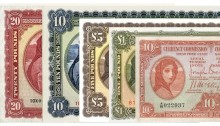Irish Coin Daily: Hiberno-Norse, Phase VII Silver Bracteate Penny. Cross with rectangle at centre and lis in each angle
Date: c. 1130-1150 Description: An Hiberno-Norse, Phase VII, Silver Bracteate Penny. Cross with rectangle at centre and lis in each angle. Weight: 0.62 g References: O’S. 73; DF. 34; S.6199 Very Fine (VF) An unusually good example of this extremely rare bracteate Very rare Obverse: Cross with rectangle at centre and lis in each angle…









